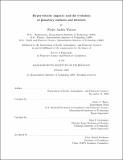Hypervelocity impacts and the evolution of planetary surfaces and interiors
Author(s)
Watters, Wesley Andrés, 1976-
DownloadFull printable version (25.60Mb)
Other Contributors
Massachusetts Institute of Technology. Dept. of Earth, Atmospheric, and Planetary Sciences.
Advisor
Maria T. Zuber and John P. Grotzinger.
Terms of use
Metadata
Show full item recordAbstract
The thesis consists of five studies relating impact processes to the evolution of planetary interiors as well as impact structures on planetary surfaces. Chapter 2 is concerned with developing methods for estimating the amount of heat deposited deep in terrestrial mantles by large impacts. Chapter 3 makes use of these results to compute the consequences of impact-related thermal buoyancy perturbations in numerical models of subsolidus convection. Among the important results of this work is a relation for the time-scale on which a buoyancy anomaly flattens and spreads before it is halted by convective downflows, as well as a condition that indicates for what perturbation magnitudes and Rayleigh numbers the flow is significantly slowed at a global scale. Chapter 4 describes a structural model of Endurance Crater in Meridiani Planum on Mars, which is constrained by observations gathered by the MER-B Opportunity rover. These results reveal new insights about the planform shape of the crater excavation flow, as well as the connection between crater shape and pre-existing structures in target materials. The study presented in chapter 5 relates the planimetric shape of simple impact craters on Mars (D < 5 km) to the geological targets in which they form, as well as rim diameter. Planform crater shape is characterized by a suite of morphometric parameters, including Fourier harmonic amplitudes and phase angles, as well as measures of deviation from radial symmetry and convexity. (cont.) In addition to finding the morphometric dependence on target properties, this work has illuminated prominent transitions between different cratering regimes, and contains a measure of the global distribution of planform elongation azimuths - which may relate to impact azimuth and provide an estimate of Mars' past obliquity variations. Finally, Chapter 6 describes a stochastic-kinematic model of the interaction between the excavation front and fractures in the target, which replicates many of the observations obtained in Chapter 5.
Description
Thesis (Ph. D.)--Massachusetts Institute of Technology, Dept. of Earth, Atmospheric, and Planetary Sciences, 2009. This electronic version was submitted by the student author. The certified thesis is available in the Institute Archives and Special Collections. Includes bibliographical references (leaves 227-234).
Date issued
2009Department
Massachusetts Institute of Technology. Department of Earth, Atmospheric, and Planetary SciencesPublisher
Massachusetts Institute of Technology
Keywords
Earth, Atmospheric, and Planetary Sciences.